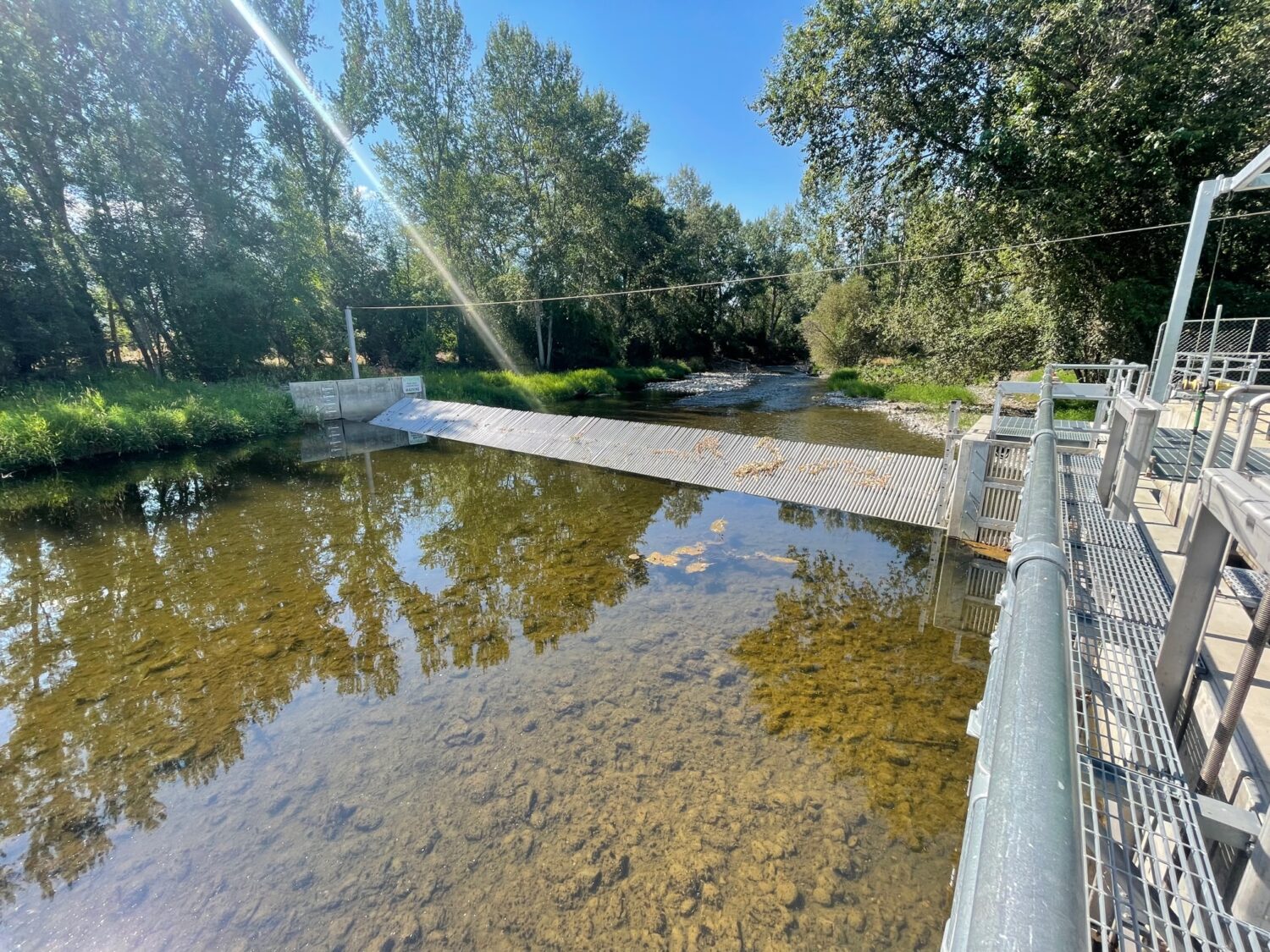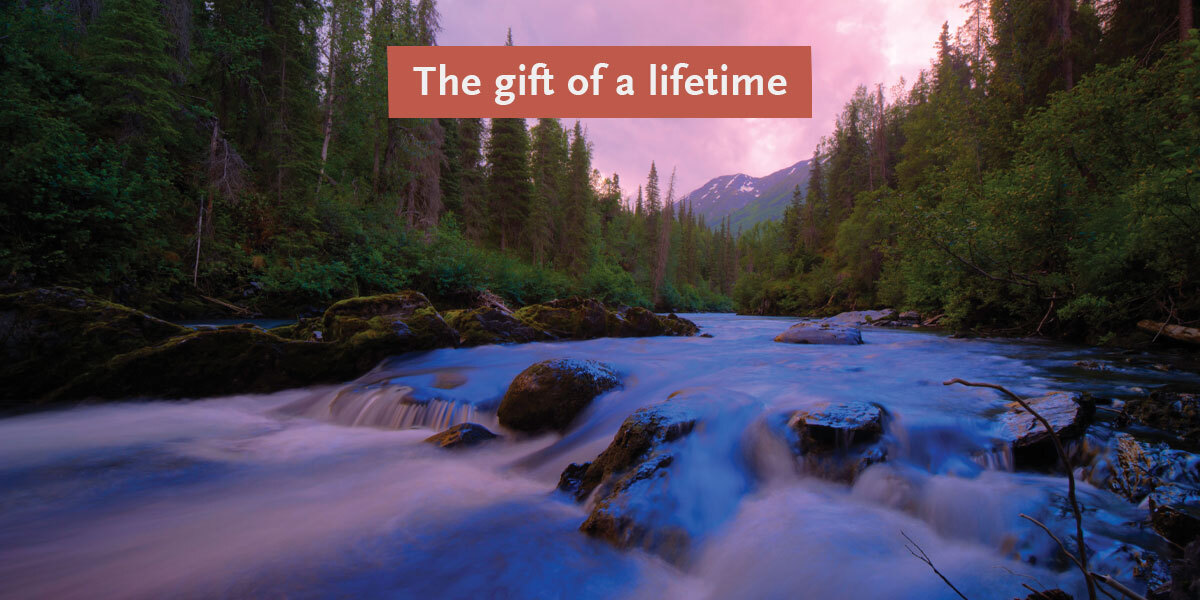An innovative water conservation project in Eastern Oregon shows a way forward for thriving farms and healthy rivers.
It’s an oppressively hot day in late August, but for two dozen people gathered on a stretch of Northeast Oregon’s Lostine River, talking about Woody Wolfe’s precision sprinkler system brings sweet relief.
On the surrounding acreage, Wolfe’s 16 new center pivots soak the soil only when needed and can be managed remotely, from his smartphone. Because of this new ease of use, Wolfe—a sixth-generation Wallowa County grain, alfalfa, and grass hay farmer—was able to do the impossible earlier this month: take ten days off in the height of summer to celebrate his wedding anniversary.
“First time that’s happened in, oh, about 20 years,” says Wild Salmon Center Water Program Director Caylin Barter, one of the water tour’s co-hosts. “Am I right, Woody?”
The joke gets knowing grins from those present—many with local roots, and familiarity with farm life in arid Eastern Oregon. Circled around Barter and Wolfe are tour co-hosts from Trout Unlimited, representatives of the Nez Perce Tribe and the Confederated Tribes of the Umatilla Indian Reservation, staff from Governor Kate Brown’s Natural Resources Office, hay farmers, ranchers, conservation groups, a state representative, a county commissioner, and Wallowa County’s watermaster, as well as state agency staffers with deep knowledge of Oregon’s increasingly precious water resources.

Also in the circle are Wolfe’s sons and other family members—some now hearing the origin story of this special irrigation project for the first time.
For everyone here today, saving time, energy, and water is a key goal. But today’s refrain is even more nuanced: to get toward those goals in today’s water reality, you also have to be willing to give.
That’s the story Barter and her co-hosts are here to tell. It’s the story of the unlikely partnership that brought Wolfe’s next-generation water management system to life: a union of farmers, fish advocates and water conservationists, enabled by new state funding—and hopefully intriguing to Wolfe’s neighbors on the Lostine and beyond.
“More people need to hear that there’s a path forward for both Oregon farmers and the salmon in our rivers, even with the pinch of our new water normal,” Barter says. “Woody’s project shows that we’re more resilient if we work together.”
“More people need to hear that there’s a path forward for both Oregon farmers and the salmon in our rivers, even with the pinch of our new water normal.”
WSC Oregon Water Program Director Caylin Barter
The Lostine River traditionally supported large runs of coho salmon, along with Chinook, summer steelhead, and bull trout.
For the Nez Perce Tribal members who lived here near the confluence of the Lostine and Wallowa Rivers—tributaries of the Grande Ronde and then the Snake—the fishing was so good that the site supported an annual fishing camp.
Chief Joseph, Wolfe notes, wanted to be buried on a hill overlooking this place—because he knew that as long as there were fish, his community would return here.
But the Lostine’s salmon-rich epoch nearly ended three decades ago. In the 1990s, those tracking Chinook spawners saw numbers drop from the tens of thousands down to mere dozens. Coho salmon entirely disappeared from the basin until being reintroduced in 2017.
One of the most critical factors for salmon survival is healthy summertime water levels in rivers and streams. At the hottest times of the year, migrating fish need enough water flowing to find cold pockets to hold in, at least until the river rises enough to let them climb higher and complete their life cycles. But increasingly, Oregon’s oceangoing fish find themselves left literally high and dry at the tail end of their home migration. (A journey that, for Lostine salmon, means the navigation of at least 600 freshwater miles and eight dams.)

That’s because July, August, and September are not only when certain salmon runs return to spawn; these months are also when agricultural water demands peak, drawing down streams across the state. This is when Wolfe would have filled his irrigation ditches with water from the Lostine to flood his fields. After Wolfe, who holds the river’s senior water rights, neighbors with more junior water rights would tap the river, and so on.
“There’s that old adage, ‘whiskey is for drinking and water is for fighting,’” Wolfe says. “In most watersheds, in the drier parts of the year, the state has issued more rights than there’s water, and that’s increasingly true, with water supplies becoming less predictable.”
A few years back, Wolfe realized that water, in fact, was his most valuable asset—more than his land and all the equipment on it.
With that realization came another: that his farm’s long-term success currently hinged on two now-risky assumptions from earlier generations. The first was that Wolfe’s status as a senior water rights holder meant his water needs would always be met—an assumption drying up as fast as the aridifying West. The second was also increasingly uncomfortable: that the century farm’s traditional water-intensive irrigation practices would continue to avoid scrutiny by state regulators.
“My view was, it’s only a matter of time before they come for you. I wanted to find a way to figure out how to be in compliance with the rules of the state, while I still had a say in my water future.”
Woody Wolfe, Wolfe Century Farm
“My view was, it’s only a matter of time before they come for you,” Wolfe says. “I wanted to find a way to figure out how to be in compliance with the rules of the state, while I still had a say in my water future.”
What Wolfe ended up working out back in 2016 came to be known as the Lostine River Conservation Project. Conceived in partnership with Aaron Maxwell and his colleagues then at nonprofit The Freshwater Trust (including Barter), the project transferred a portion of Wolfe’s senior water rights to state ownership to benefit fish in exchange for a 75 percent financial subsidy for Wolfe’s new, high efficiency precision sprinkler system: a system that now allows him to irrigate his fields on-demand and with less water.
“Even my highest concentration of problems with the pivots doesn’t equal one typical day of issues with flood irrigation,” Wolfe says.
Also built into the project is a monitoring system that enables Wolfe to easily track and report water use across his 1,100 irrigated hay and alfalfa acres. This transparency, a requirement of the grant conditions, gives Wolfe peace of mind, knowing he’s now fully compliant with state rules. The information also fills crucial data gaps for understanding his water needs.
“It was a leap of faith on both sides,” he says, referring to his partnership with The Freshwater Trust. “We had to put ourselves in a position of trust. The certainty that I was able to create around water is valuable on so many levels. And I didn’t have to give up much to do it.”
“The certainty that I was able to create around water is valuable on so many levels. And I didn’t have to give up much to do it.”
Woody Wolfe, Wolfe Century Farm
Construction of the new system was completed in 2017. Five years later, Wolfe’s crop yields are up, and his operational costs are down. Meanwhile water levels on this stretch of the Lostine have increased by up to 30 percent.
According to Maxwell, the ability to keep even a relatively small amount of extra water in the river has already proven critical to the survival of migrating Chinook salmon. This summer, more than 700 returning spring and summer Chinook were counted at the nearby Nez Perce fish weir by June 22, according to a Tribal update. That positive trend is expected to continue later this fall for returning coho.
“The Wolfe Farm helped to convince the state that funding for water conservation projects like these is money well spent,” says Maxwell, Wolfe’s original project collaborator, and now a Trout Unlimited Project Manager.

This past year, the story of the Lostine River Conservation Project helped build legislative support for and ultimately pass Oregon’s first-ever $25 million drought resilience package: legislation that allocates an additional $10 million in grants for voluntary water deals that increase streamflow, including irrigation efficiency projects like Wolfe’s.
With WSC, Trout Unlimited was part of a core group of water conservation advocates that worked behind the scenes to achieve this historic investment: a down payment, the advocates hope, in a water future that works for people, farms, and fish.
“This kind of project has the potential to show other agricultural producers that these incentives can really pencil out,” Maxwell says. “But what we’re learning is that our tools to help farmers adapt are still limited. What worked for Woody won’t necessarily work for his neighbor.”
Oregon’s water reality is changing fast, he says, and the pathways available to irrigators must adapt just as rapidly. Still needed are more legal tools and funding assistance to help farms and rivers weather drought, along with better data and improved water planning support for communities across the state.
“When it comes to keeping enough water in streams for fish, we know that even small gains are worth it,” Maxwell says. “We need more farmers to follow in Woody’s footsteps. To make that happen, we’re going to need more options on the table.”
“When it comes to keeping enough water in streams for fish, we know that even small gains are worth it. This kind of project has the potential to show that these incentives can really pencil out.”
Trout Unlimited Project Manager Aaron Maxwell
For salmon and steelhead conservationists, the connection between healthy rivers and healthy fish likely feels crystal clear. Traditionally, given the heavy impacts that agriculture can inflict on river levels and water quality, fish and farm advocates have often found themselves locking horns over dwindling water supplies.
Yet even as these conflicts play out in other forums, WSC, TU, and other conservation groups are increasingly focusing on policies to help farms bridge the widening gap between old irrigation methods and our new water reality.
Barter points to a startling number that directly impacts salmon streams: 85 percent of Oregon’s surface water use goes to irrigated agriculture—more than five times all other sectors combined. Also concerning, she says, is the fact that much of the water drawn from these rivers and streams never makes it to crop roots, thanks to leaky ditches and outdated irrigation infrastructure.
“If we want a future in which Oregon farms can grow food, Oregon rivers can grow fish, and Oregon communities can support our growing population, we absolutely have to find ways to help agriculture more effectively use our limited public water supplies,” Barter says.

It can be an uncomfortable topic, she concedes, both for tight-knit rural communities built around traditional farming methods, and for conservationists who might not have a working knowledge of those methods.
But these are conversations we need to have, Barter says. Because eventually, they can lead to collaborations like the Wolfe Farm project, where water saved through 21st-century irrigation systems is now staying in Lostine, helping salmon make it through the hot days like this one.
“Compromise can feel uncomfortable if you focus only on what you’re losing,” Barter says. “But we’re all losing from a system that ensures there’s not enough water for anyone. It’s time to work together for policies that support more wins for all of us.”
“We’re all losing from a system that ensures there’s not enough water for anyone. It’s time to work together for policies that support more wins for all of us.”
WSC Oregon Water Program Director Caylin Barter




